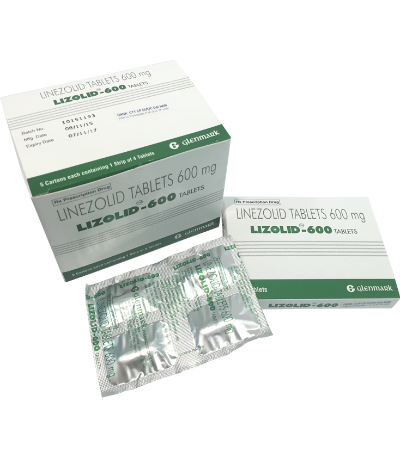


600 mg PO/IV q12hr for 14-28 days
600 mg PO/IV q12hr for 10-14 days
400-600 mg PO q12hr for 10-14 days
600 mg PO/IV q12hr for 10-14 days
600 mg PO/IV q12hr for 10-14 days
600 mg PO/IV q12hr
600 mg PO/IV q12hr for 10-14 days
Monitor: CBC count perWeek
<12 years: 10 mg/kg PO/IV q8hr for 10-14 days
≥12 years: 600 mg PO/IV q12hr for 10-14 days
<5 years: 10 mg/kg PO q8hr for 10-14 days
5-12 years: 10 mg/kg PO q12hr for 10-14 days
>12 years: 600 mg PO q12hr for 10-14 days
<12 years: 10 mg/kg PO/IV q8hr for 10-14 days
≥12 years: 600 mg PO/IV q12hr for 10-14 days
<12 years: 10 mg/kg PO/IV q8hr for 14-28 days
≥12 years: 600 mg PO/IV q12hr for 14-28 days
Monitor: CBC count perWeek
Headache (5.7-8.8%)
Diarrhea (8.2-8.3%)
Nausea (5.1-6.6%)
Vomiting (2-4.3%)
Dizziness (1.8-2.6%)
Rash (1.1-2.3%)
Vaginal moniliasis (1.1-1.8%)
Taste alteration (1-1.8%)
Oral moniliasis (0.5-1.7%)
Abnormal LFTs (0.4-1.6%)
Fungal infection (0.3-1.5%)
Localized abdominal pain (1.2-1.3%)
Tongue discoloration (0.3-1.3%)
Generalized abdominal pain (0.9-1.2%)
Lactic acidosis
Myelosuppression
Peripheral neuropathy
Disorder of optic nerve
Serotonin syndrome
Superficial tooth discoloration
Superficial tongue discoloration
Myelosuppression including anemia, leukopenia, pancytopenia, and thrombocytopenia
Sideroblastic anemia
Anaphylaxis
Angioedema
Bullous skin disorders including severe cutaneous adverse reactions (SCAR) such as toxic epidermal necrolysis and Stevens-Johnson syndrome
Optic neuropathy
Hypersensitivity vasculitis
Hypoglycemia
Hyponatremia and/or syndrome of inappropriate antidiuretic hormone secretion (SIADH)
Hypersensitivity
Within 14 days of taking MAO inhibitor
Use caution in patients with pheochromocytoma, concurrent apraclonidine, brimonidine, uncontrolled hypertension, thyrotoxicosis, carcinoid syndrome, diabetes mellitus, or seizure disorders
Phenylalanine can be harmful to patients with phenylketonuria (PKU); oral suspension contains phenylalanine, a component of aspartame; each 5 mL of the 100 mg/5 mL oral suspension contains 20 mg of phenylalanine; before prescribing oral suspension to patient with PKU, consider combined daily amount of phenylalanine from all sources, including oral suspension; the other formulations do not contain phenylalanine
Not approved for gram-negative bacteria or for catheter-related infections; clinical study showed higher mortality rate with linezolid than with other antibiotics for these conditions
Evaluate for clostridium difficile if diarrhea occurs
Peripheral and optic neuropathy reported, especially in patients given extended courses of therapy >28 days
May cause hypoglycemia; monitor blood glucose levels
Lactic acidosis reported with use; immediately evaluate patients who develop recurrent unexplained acidosis with nausea and vomiting
Superinfection may develop
Available data from published and postmarketing case reports with linezolid use in pregnant women have not identified a drug-associated risk of major birth defects, miscarriage, or adverse maternal or fetal outcomes
Drug is present in breast milk; based on data from available published case reports, the daily dose that the infant would receive from breastmilk would be approximately 6% to 9% of the recommended therapeutic infant dose (10 mg/kg every 8 hours)
There is no information on effects of linezolid on breastfed infant; however, diarrhea and vomiting were the most common adverse reactions reported in clinical trials in infants receiving linezolid therapeutically
There is no information on effects of drug on milk production; consider developmental and health benefits of breastfeeding along with mother’s clinical need for drug and any potential adverse effects on breastfed child from drug or from underlying maternal condition
Advise lactating women to monitor a breastfed infant for diarrhea and vomiting
A: Generally acceptable. Controlled studies in pregnant women show no evidence of fetal risk.
B: May be acceptable. Either animal studies show no risk but human studies not available or animal studies showed minor risks and human studies done and showed no risk.C: Use with caution if benefits outweigh risks. Animal studies show risk and human studies not available or neither animal nor human studies done.
D: Use in LIFE-THREATENING emergencies when no safer drug available. Positive evidence of human fetal risk.
X: Do not use in pregnancy. Risks involved outweigh potential benefits. Safer alternatives exist.